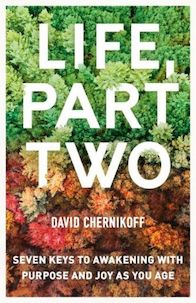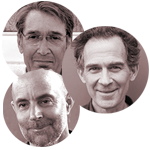choosing a vision {is the} “… second key to awakening with purpose and joy as we age … {and sustaining it involves} use of pithy phrases that can … serve as reset buttons for awareness …” ~ David Chernikoff
“Love everyone, serve everyone, and remember God.” ~ Neem Karoli Baba (Maharaji)
Whether it is Maharaji’s words above or the Buddhist phrase (from an Unknown source): “… do not create, and/or add-to, ill-will … and be an ongoing source of harmlessness …” they are both giving us an anchoring “vision” of how to be …
Choosing such a vision is what David Chernikoff calls the “… second key to awakening with purpose and joy as we age …” in his recent (Dec 21, 2021) book, Life, Part Two: Seven Keys To Awakening With Purpose And Joy As You Age …
David’s seven “keys” are: Embracing the mystery, Choosing a vision, Awakening intuition, Committing to innerwork, Suffering effectively, Serving from the heart, Celebrating the journey … each of which he adeptly unpacks in the book … and offers us a road map to awakening that’s accessible to all of us as we navigate aging in the latter stage of our life – which Jung termed as our “second half of life.”
In this post (part 2 of 2) we take a brief foray into David’s second of the seven categories: Choosing a vision …
… in Part 1, we previewed a summary of the entire book through excerpts from David’s Introduction … and then took a “mini dive” into the first of the seven keys: Embracing the mystery …
In the chapter, Choosing A Vision, David takes a deep dive into the key question: “What is my vision for the life I’m living at this stage in my journey?” … its ramifications … and the resulting anchoring visions from various traditions (e.g., Christianity, Buddhism) through stories from his life and others … while skillfully illustrating the importance of choosing such a vision … and how to sustain it. He also includes multiple examples of such an anchoring vision so you can find what might resonate for you or lead you to creating your own.
In this post we offer one of this chapter’s (entire) subsection The Use of Phrases in Sustaining a Vision which is David’s “one last dimension of choosing a vision” which is “… pithy phrases that can be recited aloud or referenced internally …” that can “… serve as reset buttons for awareness, inviting us into present time …”
This post is part of our ongoing Shambhala Publications series that offers substantive previews of selections from Shambhala Publications new and classic titles …
All italicized text below is adapted from Life, Part Two: Seven Keys To Awakening With Purpose And Joy As You Age by David Chernikoff © 2021 by David Chernikoff. Reprinted in arrangement with Shambhala Publications, Inc. Boulder, CO. Shambhala Publications has also generously offered a free downloadable PDF of the Table of Contents (link is at the bottom of the post).
You can purchase the book at Shambhala Publications or Amazon.
But before we jump to Choosing a vision, we offer David’s concluding remarks from the previous chapter Embracing the mystery …
Mystery in the Ordinary – Concluding Remarks
“… The miracle is not to walk on water. The miracle is to walk on the green earth, dwelling deeply in the present moment and feeling truly alive …” ~ Thich Nhat Hanh
Although we’re skilled at convincing ourselves otherwise, much of the time we have a very limited amount of control over the external events in our lives. It’s also true that the events that make the limits of our control clear can teach us that there is much more to who and what we are than most of us have ever imagined. Indeed, wise spiritual teachers often advise us to view our life experiences as a curriculum for awakening to our true nature. This is the sacred task in any consciously lived life. Whether or not we reach the theoretical endpoint of the journey is not the issue. What matters is the aspiration, the purity of heart that inspires us to continually open into the great unknown and become living instruments of its inherent goodness.
Ram Dass, a much-loved spiritual teacher who played a major role in waking up the baby boom generation and continued to be a beacon of elder wisdom until his death in December 2019, described the process of embracing “the ultimate mystery” in his classic book, Be Here Now:
What is happening to you is nothing less than death and rebirth. What is dying is the entire way in which you understood “who you are” and “how it all is.” What is being reborn is the child of the Spirit for whom things all are new. This process of attending an ego that is dying at the same time as you are going through a birth process is awesome. Be gentle and honor him (self) that is dying as well as him (Self) who is being born.
[…]
Choosing A Vision: The Use of Phrases in Sustaining a Vision
There’s one last dimension of choosing a vision I’d like to address in our discussion of this second key to awakening with purpose and joy as we age. It involves the use of pithy phrases that can be recited aloud or referenced internally. These serve as reset buttons for awareness, inviting us into present time, and softening our hearts when we feel emotionally triggered or confused. Each spiritual tradition has its own version of such phrases, and people sometimes make up their own. What matters is the way in which these teachings remind us to gently step out of our unconscious identification with the small self. The phrases become a flashing yellow light on our inner dashboard, reminiscent of the mynah birds in Aldous Huxley’s novel Island, which would repeatedly call out, “Attention,” and “Here and now, boys.”
Some of us find great solace in ancient, time-tested teachings of this kind. In the Jewish tradition, the prayer known as the Shema—“the watchword of our people”—serves as an invitation into presence: “Hear, O Israel, the Lord our God, the Lord is one.” For Buddhist practitioners, the refuge vows serve a similar purpose, offering people an easily accessible way to return to a source of inner strength and peace: “I take refuge in the Buddha, I take refuge in the Dharma, I take refuge in the Sangha.” In the Russian Orthodox tradition of Christianity, the classic nineteenth-century text The Way of the Pilgrim teaches the Jesus Prayer, a short formulation that serves to deepen the faith of pilgrims as they experience the inevitable ups and downs of the Way. Their practice is to “pray without ceasing,” so they continually recite their prayer: “Lord Jesus Christ, Son of God, have mercy on me, a sinner.”
Ram Dass popularized a teaching of this kind that his guru, Neem Karoli Baba (Maharaji), gave him in the late 1960s. He had been studying and practicing yoga intensively at one of Neem Karoli Baba’s ashrams in India for a number of months when he found out he had to return to the United States. Aware of how sensitive and vulnerable he felt as a result of the demanding practices he was doing and the simple, quiet lifestyle he was living, Ram Dass felt a great deal of fear and resistance when he thought about going back to the stressful, materialistic West. Before leaving the ashram, he expressed his concerns to Maharaji and asked for guidance that would help with the transition. His teacher said, “Love everyone, serve everyone, and remember God.”
I remember when I first heard Ram Dass talk about leaving the ashram and receiving that guidance. That was several decades ago. I felt like I’d been handed a compass that I could use for the rest of my life to find the spiritual equivalent of true north. In the years that followed, I’ve returned to those three phrases countless times when I feel confused, disheartened, or overwhelmed. Anne Frank said it well: “Look at how a single candle can both defy and define the darkness.”
Several years ago, I was fortunate to learn about another teaching of this kind. Angie, a friend from our meditation community in Boulder, had recently returned from a month-long retreat at Spirit Rock Meditation Center in California. I knew it was the first retreat of that length she had attended, and I was curious to hear about her experience. She was happy to tell me about it in detail, and as we were nearing the end of our conversation, she said, “There was one dharma talk that Sally Armstrong, one of the teachers, gave that turned out to be a real high point of the month.”
“What was her talk about?” I asked.
“It was about what she called ‘the Dharma in six words.’” The implication was that Sally had captured the essence of countless volumes of Buddhist wisdom in just six words. At that moment, I felt an intense curiosity. “What were they?” I asked.
Angie paused—to remember the six words or to create suspense, I’m not sure which. “Pay attention; don’t cling; be kind.”
Those six words immediately became a new touchpoint for me, one that I’ve found to be extremely helpful on a number of occasions. If I were a person who liked tattoos on my body, I’d have those words tattooed on the inside of my left forearm. As it stands, they’re etched on my heart of hearts.
[…]
~ David Chernikoff
The next post in this Shambhala Publications series will feature one of Zen Is Right Now: More Teaching Stories and Anecdotes of Shunryu Suzuki or Gurdjieff’s In Search of Being: The Fourth Way to Consciousness or Susan Aposhyan’s Heart Open, Body Awake: Four Steps to Embodied Spirituality or Radhule Weininger’s Heart Medicine: How to Stop Painful Patterns and Find Peace and Freedom—at Last … so stay tuned …
All italicized text above is adapted from Life, Part Two: Seven Keys To Awakening With Purpose And Joy As You Age by David Chernikoff © 2021 by David Chernikoff. Reprinted in arrangement with Shambhala Publications, Inc. Boulder, CO. And, click here for the free, downloadable PDF of the Table of Contents.
You can purchase the book at Shambhala Publications or Amazon.
Let us bring our collective wisdom to bear on the current humanitarian crisis unfolding in Ukraine … by helping in whatever way we can … and to that end here are some options:
1) NPR: Want to support the people in Ukraine? Here’s how you can help
2) Washington Post: Here’s how Americans can donate to help people in Ukraine.
3) Go Fund Me: How to Help: Donate to Ukraine Relief Efforts.
4) USA Today: Want to support the people of Ukraine? These apps and websites can help you send money.
— — — —
We are all facing financial challenges but IF your situation allows you to donate and help then please do so …
THANK YOU!
May you remain safe and healthy as you navigate these unsettling times across the globe.












